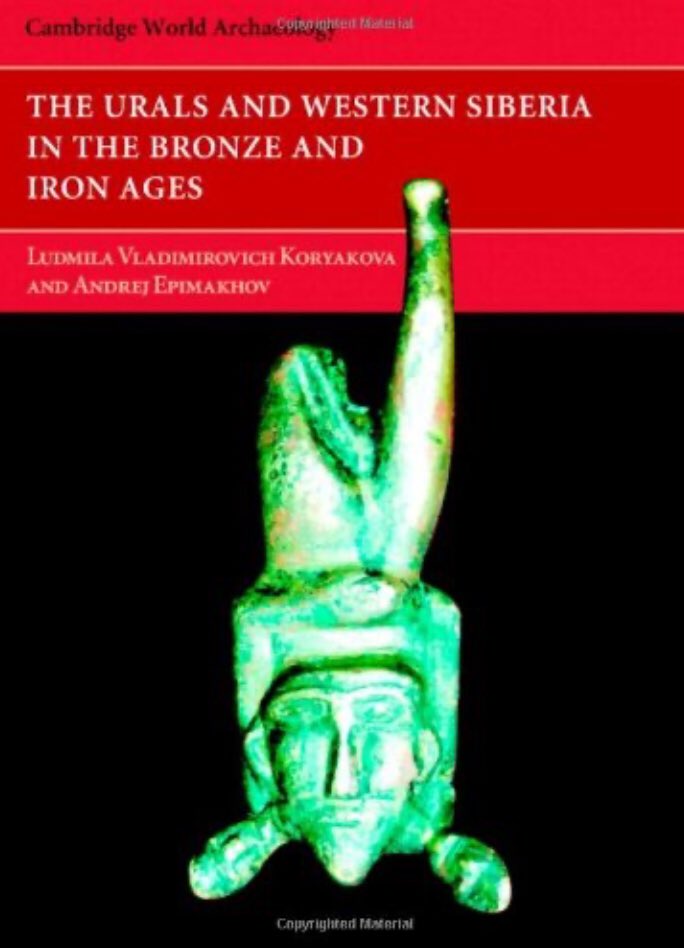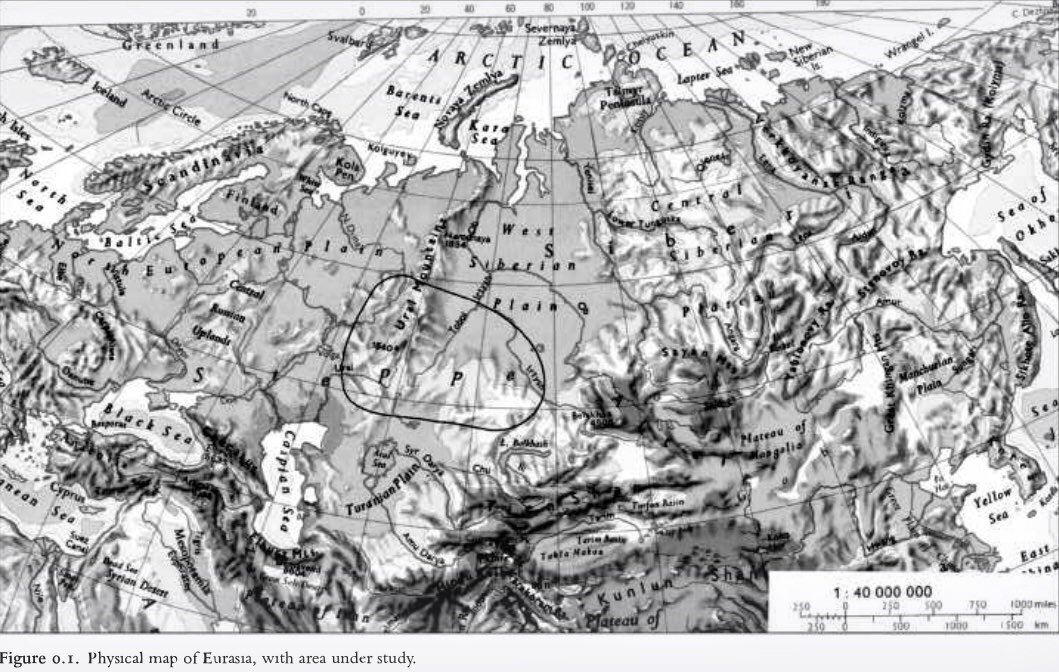Thread with excerpts from “The Urals and Western Siberia in the Bronze and Iron Ages” by Lyudmila Koryakova and Andrey Epimahov 

Useful chart with climate (thermic & wetness), culture, technology level, & century for E Europe & Urals/S Siberia. 

Technocultural networks were the technological & trade connections (most importantly for metal & metalcrafting) across large areas between different peoples, tribes & cultures. Skilled & valued craftsmen worked the metals. 



Three major prehistoric E European metalworking networks. First an Anatolian-Balkan-Carpathian which collapsed ~3700 BC, then a network around Black Sea (circumpontic) that ended towards end of Bronze Age with rise of third & much larger Eurasian network. 







Yamnaya (proto-Indo-Europeans) mined copper in W Ural region with techniques of their Caucasian neighbors ~3000 BC. The mines had been known before & primitively exploited, but exploitation & western exports dramatically increased ~3000 BC. 







Seima-Turbino phenomenon was the spread of more advanced bronze metallurgy (with resultant improved tools & weapons) from Sayan & Altai mountains to the rest of steppe & to the forest peoples (like Uralics) of the far north ~2300-1700 BC. 





Authors note many tin mines (needed with copper for bronze) in E Kazahstan & in the Irtysh River basin. Ob-Irtysh basin is the best guess for the Uralic urheimat.
Mass grave of Abashevo Culture battle casualties on the Volga who had been killed by Fatyanovo-Balanovo Culture people. Both were Indo-European cultures. 

Abashevo Culture was an IE group ruling the forest-steppe border region along the middle Volga & southern Kama, with extensions across the Urals to the Tobol River. 







Abashevo were influential across many Eurasian cultures in mid-Bronze Age, having contacts with both Seima-Turbino & Fatyanovo-Balanovo 

Sintashta built circular fortified settlements on islands in floodplains. Their walls could be 5-6 meters high, & were made of stone, earth, & wood. 







The fortified Sintashta settlements were well planned & organized by a stratified & complex society. The fortifications were similar to those of early Bronze Age Europe. Some settlements had been destroyed & rebuilt several times - likely due to warfare against unknown enemies. 





Sintashta are usually identified as Indo-Iranians. Their ritual hierarchy of animals is similar to that referenced in the Rig Veda & the Avesta (early religious texts of Hindus & Zoroastrians respectively, both dating to Bronze Age). 

Circumpontic network collapsed ~2000 BC with Catacomb culture, & was succeded by Sintashta, Abashevo, & Multi Cordoned Ware peoples. Climate change, perhaps the 4.2 kiloyear event, may have been a factor in this shift. en.m.wikipedia.org/wiki/4.2_kiloy… 



Seima-Turbino phenomena was the spread of advanced bronze weapons from E Kazahstan & Altai Mountains 1700-800 BC, perhaps from descendants of Afanasievo or Okunyevo people. They used horse-dragged sleds & riverboats to cross vast spaces of N Eurasia. 







Seima-Turbino had three routes across Urals, & none across steppe. Steppe peoples made their own metals. Uncertain if Seima-Turbino is purely result of trade between different peoples, migrations from Altai to Kama & Pechora rivers, or both. Also associated with nephrite trade. 





Srubnaya culture succeeded Abashevo culture, & spread from E Ukraine to W Siberia. It at the very least influenced the cultures of Amu Darya Basin (modern day Uzbekistan), & was culturally heterogeneous. 





Late Bronze Age megaliths from Srubnaya or Alakul culture in Bashkiria. Perhaps built towards the tail end of the Indo-European megalith revival that began in 2200 BC? 



Srubnaya were agropastoralists in Ukraine through Kalmykia, but to the north in the forest-steppe border they didn’t farm. Probably too cold - would be another 3000 years before winter rye spread to the region. 

Srubnaya in the Urals had homogeneous funerary rites, probably a sign they were ethnically homogeneous in that region as well. 

Srubnaya are believed to have originated in the Volga-Ural area as that is where most of their early sites are. They were Iranian speakers, as their transition to becoming the historical Scythians is apparent in archaeological record. 

Andronovo Culture is controversial, & was possibly several different cultures related to or influencing each other in 2nd millennium BC. They have early signs of fire worship that would play a role in Zoroastrianism. 





Plants can generate 10-20x as much biological weight as domesticated animals in same area. Bronze Age steppe dwellers could have lived on herd of 12-18 animals, mostly cattle, depending on how much they could farm & gather to supplement their diets. 





Trade networks connecting tin mines of E Kazahstan & Altai with copper mines of Urals were well integrated in the times of the Andronovo Cultures of middle Bronze Age (1900-1500 BC?). Bronze was more commonly produced, as were war chariots. Population grew, & fewer forts built. 







1750-1500 BC Andronovo people spread north into the forests & swamps of W Siberia, heavily influencing the peoples there. Possible source of Uralic words in Indo-Iranian & Indo-European words in Uralic. 





Alakul & Fyodorovo cultures were Indo-Iranian speakers. Uralics adopted Indo-Iranian gods from these cultures - Hindu gods Varuna & Mitra are parallels with Uralic pagan gods Numi-Torum & Mir-Susne-Hum. 



~1300-1200 BC the Andronovo cultures was either destroyed by or turned into a number of other cultures. Climate change possibly influenced this shift or collapse. These cultures produced inferior pottery & had fewer & smaller settlements. 







The shift occurred at the same time as similar cultural shifts from the Altai Mountains in the east to Eastern Europe in the west.
Sargary were a culture of possibly mixed Fyodorovo & Cherkaskul origins in Last Bronze Age. They had a relatively smaller population & larger horse herds. They ranged far, & had the goods of many people - perhaps evidence that they were successful & long-ranging steppe raiders. 







Mezhovka Culture existed ~1125-600 BC in forests from the Tobol River Basin in Siberia to the mid-Kama River in European Russia. They had small settlements, & relied relatively more on hunting. Possibly Uralics, or several peoples. Definite contacts with Sargary people in steppe. 







Authors argue that steppe was largely depopulated & most people lived in river valleys. They believe that C & N Kazahstan had a population of less than 10,000 in the mid-Bronze Age. 



I think this is a serious undercount. Temporary housing on the steppe wouldn’t leave much of an archaeological trace.
Best iron deposits of north-central Eurasia are in Urals & Altai, worst are in forest areas of E Europe & W Siberia. 

Ironworking long predated the Iron Age (began ~800 BC), but was rare & expensive. Wealthy Yamnaya & Afanasievo (early Indo-Europeans) used it for weapons, tools, & ornamentation. All early iron was from meteors. Indo-Europeans ceased using iron by mid-Bronze Age. 





Bronze Age Collapse & resultant trade breakdown led to cession of bronze production in the Don River Basin. Locals reverted to stone & bone tools, then figured out how to make iron tools. Their neighbors adopted iron over the next few centuries. 





Ananyino Culture ruled much of the Kama River Basin from ~800-200 BC, & was closely related to Itkul Culture east of Urals. They made advanced bronze weapons & tools in similar ways to the Seima-Turbino, & their influence reached as far west as northern Sweden. 







Itkul Culture ruled E Urals 800-200 BC, & used bronze until switching to iron production in 400s. They were an important trade partner for the steppe tribes to the south, who needed their metal. 





Sargat Culture (in modern day Tyumen Oblast) had many Chinese iron products. Sign of a northern trade route through Siberia between east & west centuries before the Silk Road. 

Chart on which cultures & peoples were active in which parts of the western steppe at which times 800 BC - 158 AD 

Brief history of the Scythians. Alexander’s campaigns disrupted balance of power in western steppe & led to their end at the hands of the Sarmatians. 



Climate of Mongolian steppe would allow for large increases in herd animal population in good years, leaving region overpopulated in bad years. The overpopulation in bad years led to many migrations west. 



Persian victories over the Massagetae & Sacae in late 6th century BC led to nomads being pushed north into Ural forest-steppe. There they fought numerous wars with their Itkul (probably proto-Ugrian) neighbors. Many small forts in the region are remnants of their old frontier. 



Roman & Chinese artifacts in the Urals 100 BC - 200 AD are evidence of northern branch of Silk Road. 





Ananyino Culture (800-200 BC) was based around Kama River Basin, & influenced the northern forest region to northern Scandinavia until 600 BC. Ananyino peoples were ancestors of Komi, Udmurts, Mari, & Mordvins. 



The appearance of Ananyino Culture coincides with arrival of “Siberian”/“Nganasan-like” ancestry & Y chromosomal haplogroup N1c in E Europe. The Finno-Ugrian invasions conquering all forested lands from the Urals to Finnmark would thus have had to have been completed by 800 BC.
Ananyino Culture built their first forts on their border with the steppe to hold off the southern horse nomads. Only after 500s BC were there forts in their core territory, perhaps indicating that a unified state or tribal confederation had fallen into warring fragments. 





Ananyino were militaristic for a forest people. Their graves have many spears, poleaxes, warhammers, battle-axes, daggers, & arrows. Weapons were sometimes decorated with wolves or griffins, even though different animals like elk were preferred as symbols in civilian contexts. 



Parts of Ananyino religion may survive in Udmurt paganism, with elements of sun worship, chthonic spirits, & animal & human sacrifice. 



Forest cultures like Udmurts would let herd animals graze in enclosed forests from spring through fall, then move them into buildings every winter to protect them from the cold. 

Pyanobor were split into many warring chiefdoms, many with their own fortresses. Sarmatian successfully invaded some Pyanobor chiefdoms in 2nd century AD & were assimilated, as were other invaders in the Migration Period. 



Ob River Basin got cooler & wetter in 900s BC, causing primitive stone age Gamayun Culture hunter gatherers to migrate west into Itkul lands. Wielding bronze weapons, the Itkul seem to have prevailed, but kept some Gamayun around as miners (slaves?) & hunters. 







I really enjoyed the book - it filled in a lot of blanks for the eastern Indo-Europeans (minus Afanasievo & Chemurchek), & had a great discussion of the west Siberian peoples.
• • •
Missing some Tweet in this thread? You can try to
force a refresh























































